Observational Study: Cancer Cases Treated with Homeopathy in the Basque Country/Navarre between 2013 and 2015- Juniper Publishers
Juniper Publishers- Journal of Complementary Medicine
Abstract
The Study included 50 women and 15 men aged between
11 and 85 years. There we 44 patients with advanced tumour disease and
21 with early-stage disease. Conventional cancer treatment was chosen by
64 patients and one of them chose homeopathy only. Four patients made
important changes in their lifestyle, and 8 had bio-decoding sessions.
All patients had taken homeopathic medicines as palliative care tailored
to different stages of their disease. A single drug treatment was used
in 18 cases, based on the entire case. Ten cases we treated by applying
Banergi protocols and constitutional medicine, and 37 cases were treated
with different successive or combined drugs, depending on the state of
the patient at the time, with the Minotti protocol for palliative care
being applied in 9 cases. The predominant homeopathic dilutions were
centesimals. The great variability of medications used on each of the
patients shows the individuality of patient symptoms with the same
clinical diagnosis, as well as the great variability in the criteria of
homeopathy doctors when establishes a therapeutic strategy.
Homeopathy has helped to control the tumour disease
(patient free of disease) in 10 cases of early stage cancer and 12 cases
of advanced tumour disease. Homeopathy was only palliative in 7 cases
of early-stage cancer, in 22 cases of advanced tumour disease, and in
five other cancers without staging. Homeopathy did not work in one case
of early stage cancer, in two cases of advanced tumour disease, and in
one case without staging. There were 5 cases in which results could not
be assessed at the time of the study. According to the subjective
assessment by the homeopathic doctor, homeopathy contributed to the
control of tumour disease (patient free of disease with biological and
/or imaging tests) in 22 cases, it was palliative in 34 cases, 4
patients died, and 5 cases cannot yet be evaluated. According to the
assessment by the patient, it helped to control and improve their
quality of life in 55 cases and it does not help them at all in 5 cases.
This observational study has enabled us to evaluate the effectiveness
of our work in the context of our clinical reality and more accurately
describe all parameters involved in the case, including conventional
treatments and their impact. Patient opinion is part of the evaluation
of the results and requires questionnaires that can be adapted and
standardized. Homeopaths carry out their work within an ethical
framework bound by civil responsibility and respect for patient
autonomy, open to collaboration with the work of the other professionals
with a common goal, which is none to cure, relieve the patient, and
contribute to the advancement of knowledge.
Keywords: Advanced tumour
disease; Early-stage disease; Lifestyle; Bio-decoding; Palliative;
minotti protocol; Patient free of disease; Staging; StandardizedIntroduction
Homeopathy exercised by doctors is abided to a
deontological code common to the medical profession and to a social
responsibility setting established by law. Moreover, we homeopath
doctors respect the patient’s autonomy and do not compete with other
therapeutic possibilities. We homeopath doctors are willing to
collaborate with other medicine professionals and to equip ourselves
with investigation and evaluation tools that will permit progress of the
scientific knowledge.
What does homeopathy offer to oncology patients?
Active listening, reflection scenarios, full symptomatic patient treatment and use of medicines with few and reversible
adverse effects compatible with chemotherapy, radiotherapy
and hormonotherapy. Another, not least important aspect is that a homeopathy treatment is short and inexpensive.
Reflection scenario: raising awareness
These four questions open a therapeutic space of
active listening for the patient and the doctor (Figure 1). The patient
evolves from being a case of adenocarcinoma to being an ill individual
to whom we intend to help by searching for the most accurate medicine
that suits him, his suffering and the tumor. The patient must understand
his vulnerability and those facts, emotions or ways of life that make
him sicken. For that he is given a reflection space. We do not speak
about statistics or predictions. We commit ourselves to him, to help and
attend his needs. Undoubtedly, in our job as homeopath doctors this
active
listening is part of our therapeutic grounding.
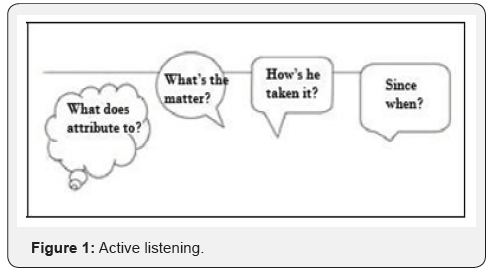
Approaching the oncology patient
The oncology patient is a complex one. Besides his natural
illness (the tumor), he also presents an artificial sickness derived
from the adverse effects of his oncological treatment. Moreover,
the impact of the diagnosis as well as the disease prognosis that,
just by themselves, many times destabilize the patients, must
be also be considered. For the homeopath, restoring the mental
and physical equilibrium of the patient is a priority. Help him
bear the treatments, make him lead the processes and maintain
the hope alive, are also essential. In this case, a respectful
atmosphere for cooperation would be the ideal for the patient
and the treatment’s result.
Observational Study (Appendix 1)
Sample
a. 65patient cases with different cancer diagnosis are
collected at homeopath consultations in the Basque country/
Navarre during the period 2013-2015.
b. Monitoring for 18 of the cases has been done at a health
public service (primary attention) as for the rest 47 cases
monitoring has been done at private consultation
c. Patients from both sexes: 50 women and 15 men
d. Ages between 11 and 85 years old
e. A total of 44 patients present an advanced tumor
disease
f. 21 patients present the disease in an initial localized
phase
Diagnoses
Table 1 shows the diagnoses along with the correspondent
phase and number of cases. Simultaneous treatments to the
homeopathy treatment (Table 2).

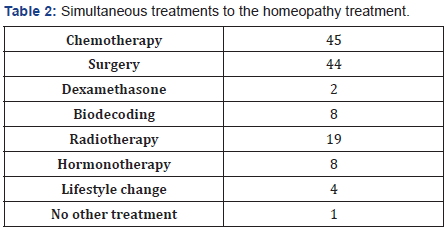
Common treatment
Common treatment includes a combination of different
procedures in which following different protocols, chemotherapy,
radiotherapy, surgery and hormonotherapy can be combined for
a healing or palliative purpose.
Lifestyle change
Lifestyle changes include change processes in habits such
as diet or tobacco consumption, as well as changes in work,
personal or family relations starting by a conflict awareness
raising from the patient.
Biode Coding
Awareness raising and emotional unloading in relation to the
conflict that unleashes the disease following a specific technique.
Used strategies at the homeopathy consultation
a. All sample patients have taken palliative treatment
adapted to various disease stages.
b. Patients given a single medicine base on the situation
and patient’s constitution: 18 cases.
c. Banergi protocols and patient constitution based
medicine: 10 cases.
d. Other combined or successive medicines adapted for
the patient: 37 cases.
e. Minotti’s protocol (PAC): 9 cases.
Potency usage in prescriptions
Table 3 shows the prescribed potencies. The homeopathic
medicine stimulates the healing capacity of every patient.
Moreover, it also, at the same time, acts in the mental, emotional
and physical areas. It is this aspect to which we refer when we
speak about totality. The homeopathic medicine is compatible
with other treatments and has few adverse effects. The great
variety of the medicines used in each patient expresses the
symptom individuality of the patients with the same clinic
or anatomopathological diagnose. Also, expresses the great
criteria variability of the homeopath doctor when establishing a
therapeutic strategy.

*Solution to the following medicines: ADN 6 CH, Hepatine 6 CH, Bone
marrow 6 CH, Cardine 6 CH, Anilium 6 CH, Hairy Cranium Area 6 CH
(Dr. Minotti’s formule).
Homeopathy effectiveness estimation at the case management
Homeopathy has contributed to control the tumor disease
(free of disease patient) at the following cases (Table 4):
a. Localized tumor disease (N0, M0): 10 cases
b. Advanced disease (from phase II onwards): 12 cases
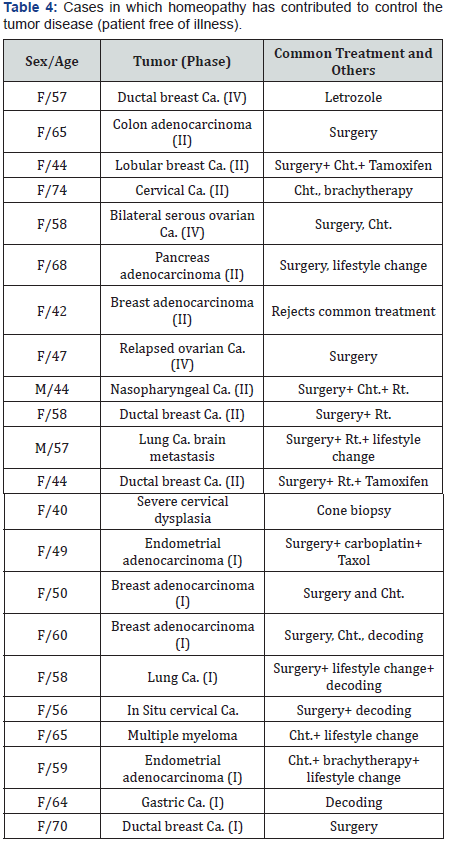
Homeopathy has turned out to be palliative only at the following
cases (Table 5):
i. Localized tumor disease (N0, M0): 7 cases
a. Advanced illness (from phase II onwards): 22 cases
b. Non-determined phase cases: 5 cases

ii. Homeopathy has not worked in the following cases
(Table 6):
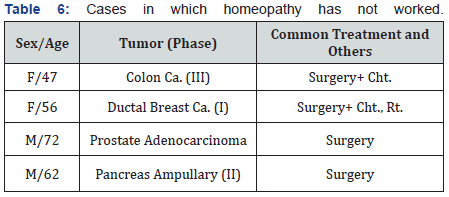
a. Localized tumor disease (N0, M0): 1 case
b. Advanced illness (from phase II onwards): 2 cases
c. Non-determined phase cases: 1 case (Table 7)

iii. Efficacy estimation based on the doctor:
a. Contributes to control the tumor disease (at the
actual moment, free of illness patient with biopsy, image,
scoreboards, endoscopy, etc. records): 22 cases.
b. Contributes only to palliate the effects of the disease or
treatment (chemotherapy and radiotherapy), quality of life,
tolerance to adverse effects: 34 cases.
c. Dead patients: 4 cases.
d. Cannot yet be established if the treatment works: 5
cases.
e. Treatment does not work: 4 cases
iv. Effectiveness estimation based on the patient:
a. Has helped to control and improve my quality of life
during the treatment: 55 cases.
b. Has not helped at all: 5 cases.
c. Without opinion: 5 cases.
Used homeopathic medicines
1) Constitution based medications:
A. Natrum Muriaticum: 9 cases.
B. Pulsatilla: 8 cases.
C. Lachesis: 4 cases.
D. Calcarea Carbonica: 4 cases.
E. Veratrum: 2 cases.
F. Staphisagria: 8 cases.
G. Samarium: 1 case.
H. Alumina: 1 case.
I. Germanium: 1 case.
J. Ustilago: 1 case.
K. Sepia: 8 cases.
L. Aurum Metallicum: 6 cases.
M. Ferrum Phosphoricum: 3 cases
N. Aconitum: 3 cases.
O. Sulphur: 2 cases
P. Aranea Diadema: 1 case.
Q. Silicea: 1 case.
R. Ignatia: 1 case.
S. Argentum Nitricum: 1 case.
2) Medicines in relation to the tumor disease:
A. Conium Maculatum: 14 cases.
B. Phytolacca: 10 cases.
C. Kalium Carbonicum: 4 cases.
D. Chelidonium: 3 cases.
E. Hydrastis Canadensis: 3 cases.
F. Asteria Rubens: 2 cases.
G. Rhododendron: 1 case.
H. Carcinosinum: 8 cases.
I. Thuya: 9 cases.
J. Kalium Bichromicum: 3 cases.
K. Calcarea Phosphorica: 3 cases.
L. Ruta: 2 cases.
M. Carbo Animalis: 2 cases.
3) Table 8 shows the medicines used with palliative
purpose for:
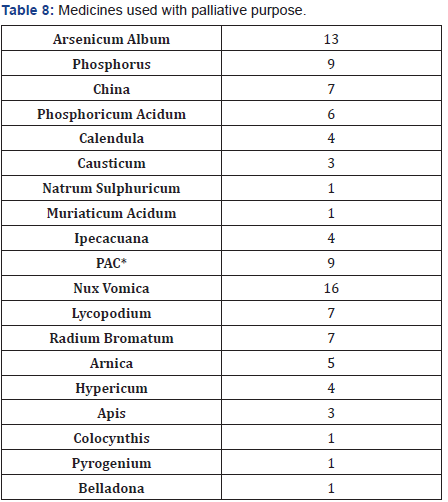
A. Radio dermatitis
B. Mucositis
C. Nauseas and vomits
D. Weakness
E. Sadness
F. Fear
G. Swelling
H. Post-operative
I. Anemia
J. Leukopenia
K. Thrombocytopenia
L. Helps to die
M. Dyspnea
How can we know, with accuracy, the effectiveness of our intervention?
To us, homeopaths, can be reproached that we do not publish
our results, which is true, we barely do it. The purpose of the
homeopathy associations and academies, is to offset this reality
raising awareness amongst our colleagues of the importance
of recording the cases homogenously and of publishing clinical
results, at least, in our magazines. Due to the nature of the
homeopathic practice, we must also explore new designs to
contrast our results. We must change the subjective assessment
of our work with validated tools from the general medicine
sphere such as the life quality tests proposed by the EORTC
(European Organization for Research and Treatment of Cancer)
and other tools proposed by the ECH (European Committee
for Homeopathy). In one word, use the common language of
science to contrast our results. We prepare ourselves to search
a respectful collaboration with other medicine professionals
that help patients from a conventional perspective. This is the
propose of integrative medicine: the patient improves and the
science makes progress [1-6].
Conclusion
At the presented sample, we are conscious that at the time
of collecting the data, the free of illness patients still have a long
journey of regular medical checks and that, at worse, they might
present relapses of their tumor disease. Our purpose as doctors
is to be available at this stage of the patients’ life. Nowadays, one
of the cancer treatments objectives, in those cases in which the
illness cannot be cured, is to make the disease a chronic one. In
our sample, there are two patients that present this situation
and undoubtedly, homeopathy along with other procedures
(palliative chemotherapy, hormonotherapy, etc.) helps them to
get along with their lives.




Comments
Post a Comment